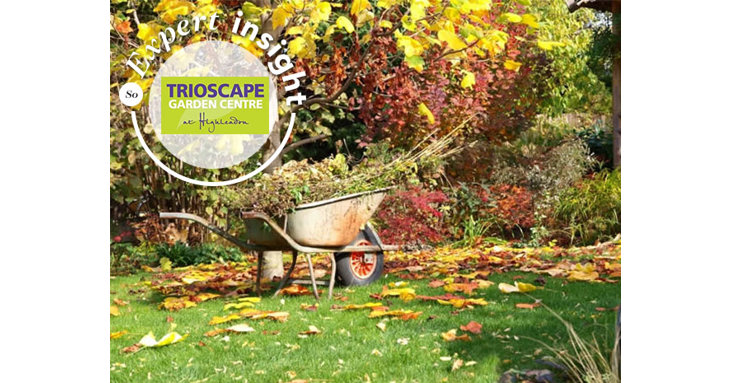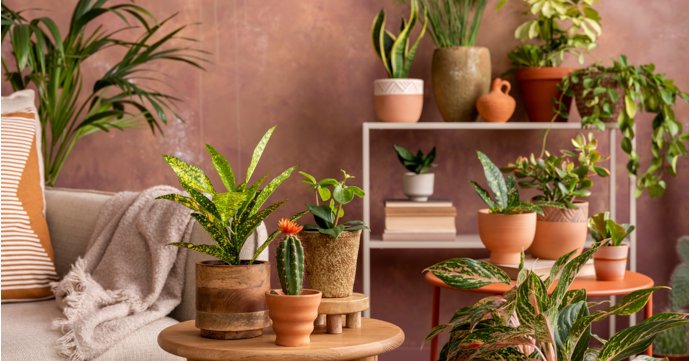With summer drawing to a close, it’s time to get your garden ready for the arrival of autumn – heralding a new season that’s a marked change from the hectic flowering of the summer months.
The expert team at Trioscape Garden Centre in Newent have plenty of tips for what to do in your garden during September, October and November, with advice for amateur and seasoned gardeners alike.
If you need to stock up on bulbs, plants, accessories or tools, the independent Forest of Dean garden centre has all your horticultural needs covered.
September
Planting
Continue to feed and dead-head your hanging basket and container plants – they will often keep going until the first frosts. Prune climbing roses and rambling roses once they’ve finished flowering, unless they are repeat-flowering, in which case leave them.
Start to divide herbaceous perennials as the weather cools. Make sure you water in the new divisions well. Fill gaps in borders with autumn flowering plants such as sedum and chrysanthemum to extend the colour to the end of the season.
Plant spring-flowering bulbs such as daffodils, crocus and hyacinths now, and hyacinth and amaryllis bulbs for forcing, to ensure a crowd of colourful blooms at Christmas. These are perfect for a home-made Christmas present!
September is a good time to plant new perennials as the soil is still warm but there is generally more rainfall. With wetter weather arriving this month, it’s the ideal time to order trees and shrubs. They will grow vigorously next spring if planted this autumn.
Grow your own
Keep harvesting crops. If you have a glut of fruit and veg try freezing, drying, pickling, and storing so that you can benefit from them later on. Take a look at Trioscape’s website for ideas on what to make with your produce!
Start the autumn cleanup. Remove any old crops that have finished and clear away weeds to leave your plot clean and tidy for the winter.
Help your pumpkins ripen in time for Halloween by removing any leaves shadowing the fruits. Place pumpkins and squashes on a piece of slate or wood to raise them off the wet soil and prevent rotting.
The end of this month is the perfect time to start planting garlic bulbs for cropping next year.
In the greenhouse
Empty pots, old compost and decaying plant material can harbour unwanted pests in your greenhouse and provide ideal shelter for them over winter. Clean out your greenhouse to reduce the risk of pests and diseases next year.
Don’t forget to remove the shading from your greenhouse towards the end of the month so that your plants receive the maximum amount of light.
Water early on in the day so the greenhouse is dry by the evening. Damp, cool nights can encourage botrytis. Close vents and doors late in the afternoon to help trap in heat overnight. This will ensure your plants crop for as long as possible.
Maintenance
If you have clay soil, now is the best time to improve it before it becomes too wet or frozen. Incorporate organic matter and/or horticultural grit. Sow green manures such as mustard, clover and rye grass on uncultivated areas to improve soil and keep weeds down over winter.
Create compost bins in preparation for all the fallen leaves and dead plant material which you’ll be collecting over the coming months. Autumn leaves make a great addition to compost bins but make sure you dispose of diseased plant material by burning it or putting it in with your household waste. Don’t compost it as the spores may remain in the compost and re-infect your plants.
Raise pots off the ground for the winter by using bricks or ‘pot feet’, to prevent water-logging. And, install water butts to collect rain water which is great for watering ericaceous plants such as blueberries, rhododendrons and camellias.
October
Planting
Plant daffodil bulbs, tulip bulbs and allium bulbs for a glorious spring display. Dot them through borders or naturalise them in grass. It’s also a good time to plant spring bedding such as wallflowers, bellis, primulas and winter pansies.
Plant bare root ornamental trees and shrubs, clematis plants; move trees and shrubs, and plant hedges; and now that colder weather is approaching, protect half-hardy plants with fleece or bring into a frost-free greenhouse.
Clear up fallen rose leaves to prevent diseases such as black spot from over-wintering – don’t compost the leaves.
Cut back perennial plants that have died down or alternatively leave the dead foliage in place for over-wintering wildlife. Lift and divide any overcrowded herbaceous perennials whilst the soil is still warm.
After tidying borders, mulch with bark chips, well rotted manure, leaf mould or spent mushroom compost to insulate plant roots for the winter and keep weed growth in check.
Grow your own
Finish harvesting beans and peas. When beans and peas finish cropping simply cut the plant away at ground level, leaving the roots in the soil. These crops fix nitrogen which is slowly released into the soil as the roots break down.
Protect autumn cauliflower heads from frost by wrapping the outer leaves around them and securing with string. Alternatively use a cloche or fleece.
If you haven’t done so already, cut back the fruited canes of your summer fruiting raspberries, leaving the new green canes for next year’s crop. Tie in next year’s raspberry canes to support wires or fencing.
Move citrus trees indoors to a bright, frost free position (4-12°C) away from cold draughts and radiators. Reduce watering in winter but do not let the plant dry out completely.
In the greenhouse
Move tender plants into the greenhouse to protect them from early frosts. Make sure that there is enough space between them to keep them well ventilated and reduce the risk of disease.
Check any plants which you are bringing inside for pests such as aphids.
Continue to remove any fallen or dead plant material to keep the growing area free of fungal diseases.
Maintenance
Clear up fallen leaves regularly to allow light to the grass. A last mowing can be made this month before leaving your lawn for the winter.
Finish off essential lawn maintenance to avoid waterlogging and compaction over winter. Try aerating your lawn with a garden fork, raking thatch from the surface and repairing dead patches. Fresh turf can still be laid now as autumn rains should ensure the turf settles successfully.
Sweep up debris and fallen leaves that harbour overwintering fungal spores and hiding places for slugs and snails.
If the soil is dry, give your garden one last good watering before the ground freezes, and make time to give evergreen hedges a final trim before the bad weather sets in, so they look neat and tidy for the winter.
Use the last of the dry weather to paint sheds and fences with preservative before the winter arrives. And invest in bird baths and bird feeders this autumn. Birds are gardeners friends and will keep pest numbers down.
November
Planting
There’s still time to plant daffodil bulbs and other spring flowering bulbs for a magnificent start to next year’s display. Plant up a terracotta pot of hyacinth bulbs for a simple but stunning display next spring.
Start to plant bare-root roses – they can be planted any time between now and March. Now is also the ideal time to plant a magnolia tree for a beautiful spring display.
Cut back the yellowing foliage of herbaceous perennials, and lift and divide overcrowded clumps to maintain their vigour.
Before the birds eat them all, cut a few stems of holly with berries for making Christmas garlands. Stand them in a bucket of water in a sheltered spot where our feathered friends can’t take them.
Grow your own
Prepare a perennial vegetable bed which can be planted up with rhubarb crowns and asparagus crowns. November is also a good time invest in mushroom kits.
Prune pear and apple trees anytime between now and February. But don’t be tempted to prune your plum trees now as they will be susceptible to the silver leaf fungus – wait until midsummer.
If you have access to fresh manure, now is the time to spread it across the surface of your vegetable beds to rot down over winter.
Apply glue bands or greasebands to the trunks of fruit trees to prevent wingless female winter moths climbing the trunks and laying their eggs in the branches.
In the greenhouse
Clean out the greenhouse thoroughly. Wash the glass, the floor and the staging with horticultural disinfectant to kill any overwintering pests and diseases.
Install solar lights in the greenhouse so that you can still get out there on dark winter evenings to check your plants. Insulate with sheets of bubble wrap attached to the inside of the frame, to reduce heat loss, and don’t forget to ventilate the greenhouse, particularly after watering and when paraffin heaters are used at night.
Maintenance
Wash, dry and store any used pots, seed trays and containers to remove overwintering pests and diseases that may infect your plants next year.
Make sure gardening tools are cleaned of soil and debris. Once dry apply linseed oil to prevent rusting over the winter.
Tidy up canes from around the garden. Make sure that you let them dry out before storing them away. This will help to extend their useful life.
Insulate taps and pipework with foam lagging to prevent damage caused by freezing weather conditions.
For more information, see Trioscape Garden Centre, call (01452) 790550, email gardencentre@trioscape.co.uk or visit trioscape.co.uk directly.





















